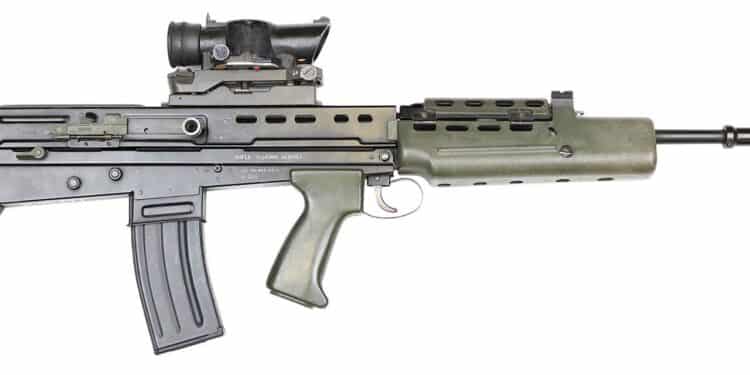By Jonathan Ferguson, Photos Courtesy of Armament Research Services
The final prototype series of the SA80 family actually overlapped with the service L85A1 and L86A1 variants and consisted of 10 variants; although the E1 is the only pre-production build standard. All others were created afterward (1987-1990) to address ongoing reliability issues (see below):
- XL85E1, E2, E3, E4 & E5 Individual Weapon (IW)
- XL86E1, E2, E3, E4 & E5 Light Support Weapon (LSW)
Throughout development “IW” and “LSW” were used interchangeably with “Rifle” and “MG.” This is not a case of confusion so much as a hierarchical nomenclature. One set of terms reflects a weapon’s role (specifically, its NATO standardized role), the other its class. In theory, weapons other than a machine gun may fill the light support weapon (LSW) role—an automatic grenade launcher, for example. Similarly, an individual weapon might not necessarily be a rifle—unrifled weapons firing fléchette projectiles were considered by several countries, for example.
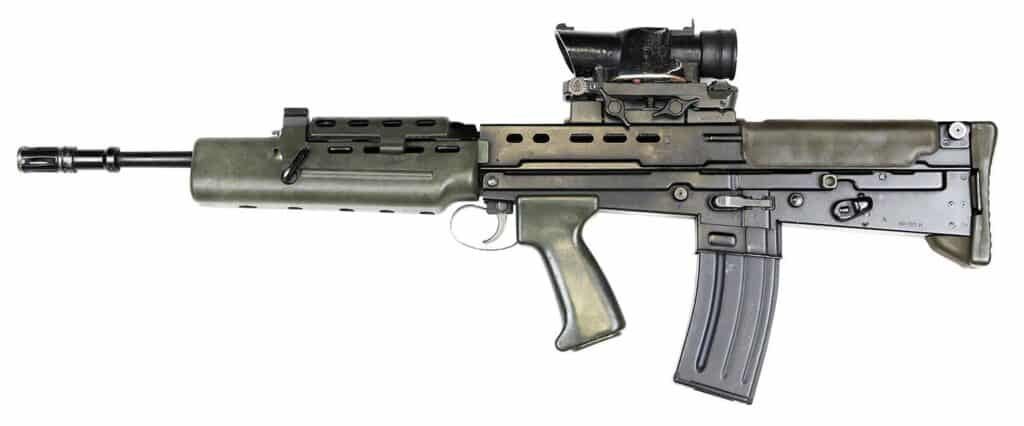
Despite the loss of a dedicated left-handed variant, at this point left-handed users of the IW were still to be catered with an armor-er-level conversion kit. Details on this are lacking, but presumably this would have taken the form of a “bare-bones” barrelled upper into which the donor weapon’s working and gas parts were transferred (the bolt would have to be replaced, however).
The new wedge-shaped receiver introduced on the XL70 series was carried over to the XL80 series, but the whole unit was redesigned in detail, re-toleranced, and the method of welding was changed. The rear sling loop was once again deleted. Two important external changes were also made. The extended magazine well added to the XL70 series was very much an afterthought, and neither the best nor the cheapest way to achieve the intended functional design. With the XL80 series, a new magazine housing insert was designed. Tabs were added to the redesigned TMH in order to support it and provide a surface to spot weld it in place (in lieu of the previous seam weld). The stop-lips remained an integral part of the TMH, however. The re-engineering of the XL70 into the XL80 added still further to the weight of the rifle (another 30g). The weapon was not going to meet the 3.2kg target originally set, and with optical sight it weighed only 83g less than the 7.62 x 51mm SLR (FN Herstal FAL) that it replaced (without an optical sight). Although a lot of this excess weight was thanks to the value engineering done on the design and the arguably over-engineered SUSAT sight, a fair amount lay in the barrel profile (carried over from the XL70). This appears thin from the outside, but tapers up drastically under the handguards, becoming very thick and heavy near the chamber. Fortunately, this is near the point of balance, and so for handling purposes the weapon does not feel its weight.
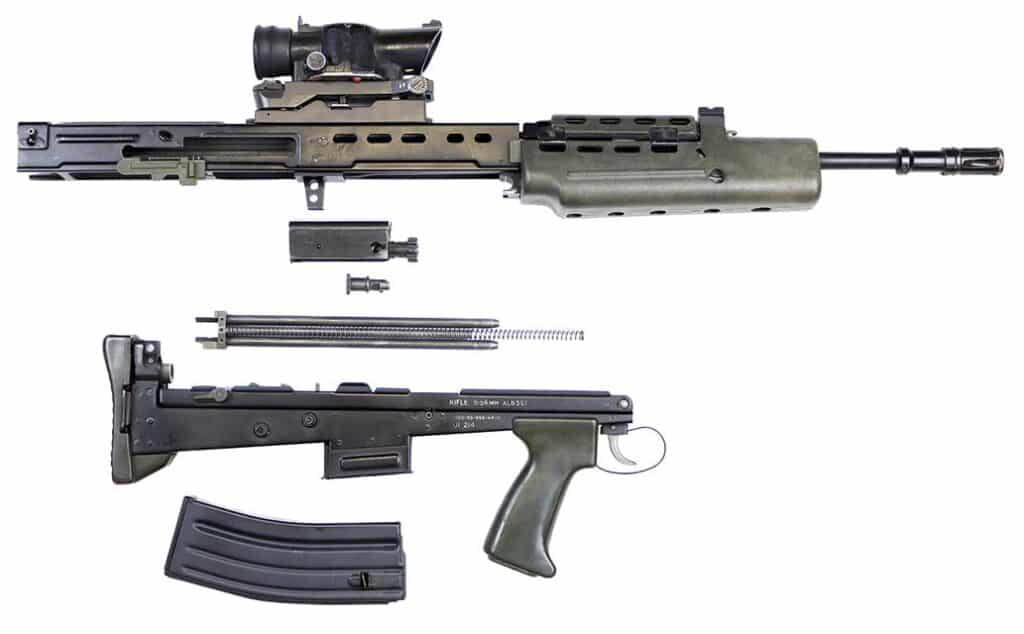
The other major change in this series was the “outrigger” support added to the LSW forend. This was added in order to mitigate a long-running issue with the type; that of split groups on target. The first shot would impact in one place and the remainder of the group several inches away. This seems to have been caused initially by the tapered barrel profile; the second and subsequent shots of a burst being subject to the flex induced by the previous shot. It was likely made worse by positioning of the bipod in earlier designs: clamped around the barrel forward of the handguard, limiting movement of the thicker rear portion and exaggerating the “whip” of the muzzle. The out-rigger solution effectively clamped the end of the barrel in place, producing a stiffer barrel without increasing its weight (although the outrigger itself added weight to the weapon). This was a quick and dirty fix compared to a fuller redesign that would allow for a fully free-floated barrel. For the same reason, the weapon also received a new vertical grip towards the rear of the weapon and was fitted with a folding wire butt-strap (the angle of the latter being altered due to trials feedback). Nonetheless, whereas the IW was accepted for service in January 1984, the LSW was deferred until later that year. As an aside, despite the split group issue, the LSW eventually went on to acquire a reputation for accuracy in semi-automatic mode and has even been used in an expedient designed marksman’s rifle (DMR) role. The LSW handguard was now fully developed, matching the IW design in most aspects but retaining the truncated hand-stop shape prototyped on the XL73E2. Both the rifle and MG also received new flash suppressors of a cylindrical, slotted bird-cage design, although these were not interchangeable.

At this point in the history of the SA80, politics and recrimination began to overtake actual firearms history. Much has been made of the drive to sell off the Royal Small Arms Factory at Enfield for profit, a narrative in particular of Steve Raw’s The Last Enfield. This is an oversimplification. What actually happened was that the publicly owned factory was combined into a new private sector company along with the Royal Ordnance Factories (ROF), a number of which still existed despite post-Second World War closures. This was incorporated as Royal Ordnance plc (public limited company) and was founded with the intention of floating it on the stock market. The UK government of the day was committed to a policy of privatising public organizations. This may therefore be seen as primarily an ideologically and politically motivated move, rather than simply selling off the proverbial family silver. The goal was to preserve the UK’s organic small arms and ordnance manufacturing capability by forging it into a viable private company; Mrs. Thatcher’s government took the view that such bodies could not survive without substantial government subsidies, as we have seen at play in other countries with legacy national arsenals. Unfortunately, despite an injection of public money and the sale of ROF Leeds, the company could not be made into an attractive investment, and flotation plans were abandoned. Royal Ordnance was put up for sale after all, giving rise to the somewhat plausible, but nonetheless unlikely, conspiracy theory that this had been the secret plan all along. Thus, in 1987, British Aerospace (now BAE Systems) purchased the company for £188.5 million and, only a year later, had begun to sell off assets that were deemed unprofitable. Enfield was one of these.
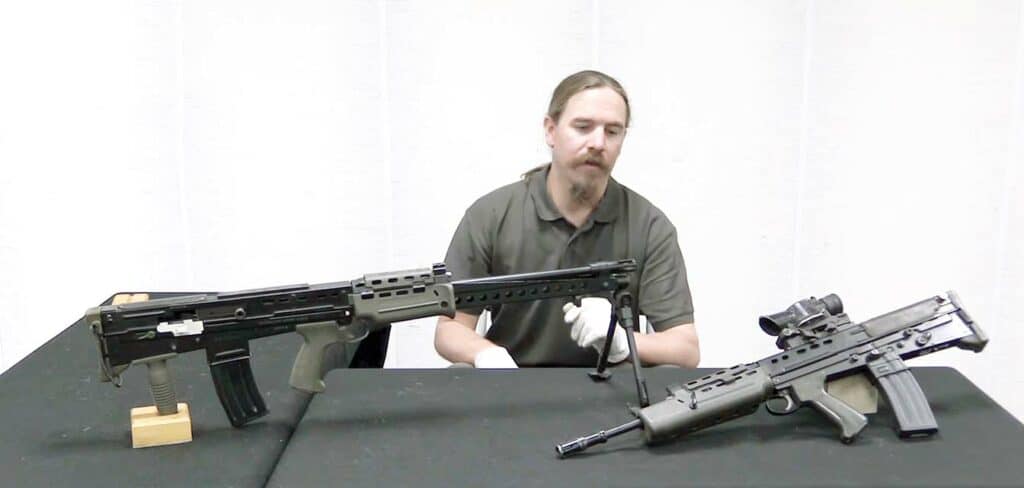
Regardless of the details, morale at the factory was low. Enfield workers felt their livelihoods threatened as UK industry in general suffered job losses. The government’s privatization agenda suggested to many that even if jobs did persist in the firearms manufacturing sector, these would not be at Enfield. Many were not in a position to move to follow new jobs, and there would not be enough positions to go around even if they could. Like their rivals Sterling, RSAF Enfield were by this time a one-trick pony. Even if SA80 were a success, the UK’s limited civilian market, few products to market for export and shrinking armed forces mean that difficult times were all but certain.
The closure of Enfield spelled the end of an era for British firearms manufacturing. Worse was to come for both the industry and for the SA80. Although the intent of this series is not to apportion blame for the SA80’s early troubles, and the subject is a complex and opaque piece of firearms history, the critical factors boil down to Enfield (and the UK government more broadly) biting off more than it could chew. The days of expert firearms design and unlimited resources were long gone, whereas manufacturing technology had moved on and left the old factory behind. It lacked modern manufacturing expertise, and the famous quality control of the past had clearly lapsed. It even lacked firearms design experience. The original designer, Sydney Hance, was apparently the only member of the original Enfield team with previous experience of designing firearms, and he retired in 1976. The finalized XL64E5 depicted in Hance’s U.S. design patent #251,979 of May 29, 1979, shows that he was involved right up until this major redesign. According to Raw, he believed that his design was sound at that stage and had gone awry after his retirement from the factory. This is by no means certain given the fundamental issues that all of the SA80 build standards suffered, but the oversight of an experienced firearms designer and less enthusiastic cost-cutting measures might just have seen the Hance EWS through to a more successful outcome than the SA80A1. Matters were made much worse by a set in-service date and an insistence upon cost saving, as well as formal acceptance of the weapon system before it was ready for actual use.
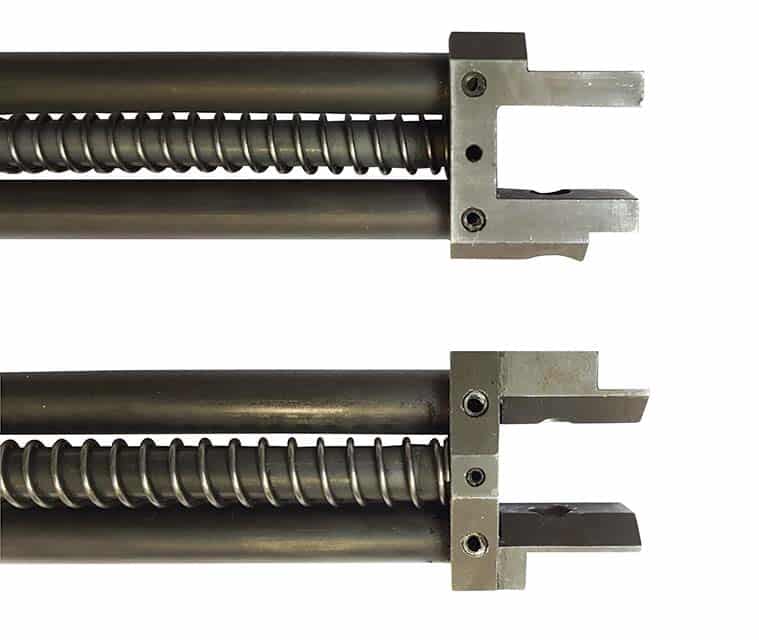
In fact, issues with the SA80 did not stop with its formal acceptance and type classification as L85A1 IW and L86A1 LSW. Mechanical issues, and modifications to address these, were ongoing. The first steps were taken with the E2-E5 series mentioned above, a continuation of the XL80 series produced for environmental trials. None of these translated directly into improved service variants as the XL/E1 series had. Instead they acted as test beds for a raft of experimental tweaks to the working parts, gas parts and other areas. For example, the alloy used to manufacture the bolt was changed, different-sized gas port and gas plug apertures were tried, and a double-nested return spring was trialled.
In the case of the XL86E3, the only external changes visible are the experimental white nylon safety catch and “Ejection Opening Cover” (dust cover). On some guns, a large paddle-shaped cocking handle/case deflector was also fitted. Most of these changes were not embodied in the production weapons. The serial number shows that this XL86E3 was manufactured in 1987, two years after the L86A1 had already been introduced into service. However, it has not been fitted with the first pattern magazine catch shroud, introduced during that same year to prevent accidental pressing of the catch and loss of the magazine (a common issue in service). This gun has also been fitted with the second pattern of trigger, fitted to production guns from 1985. This was made heavier to prevent inadvertent firing when dropped on the muzzle. Conversely, the XL85E1 shown has the first pattern, pressed sheet metal trigger. This change had not been trialled on E2-E5 guns, but feedback from those trials resulted in the third pattern snow clearance trigger still in use today. Note also the “ENFIELD®” commercial maker’s mark on the TMH, not found on service weapons (in contrast to the first two “Enfield” rifles, the Pattern 1853 muzzle-loader and the Lee-Enfield magazine rifle).
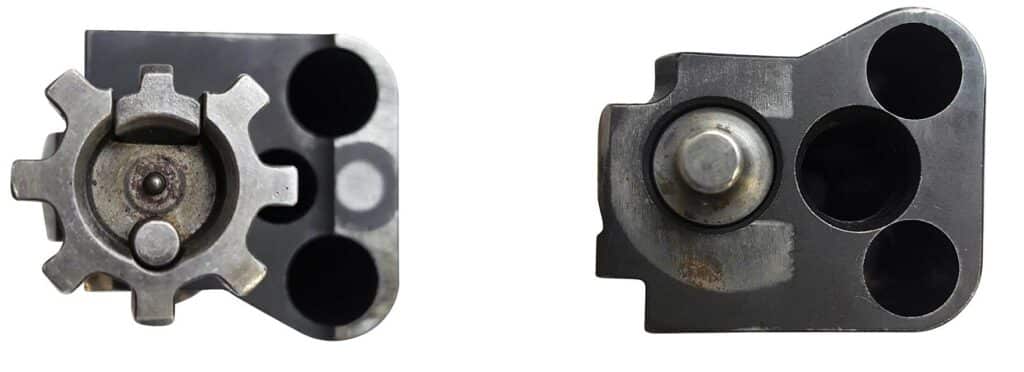
The many subsequent trials and “mods” incorporated into the SA80A1, while not reflected in distinct experimental variants, are detailed in Steve Raw’s book. However, it is worth noting here that not all of the A1 series issues were inherent to the guns. When they were introduced, the proprietary Radway Green magazines (identifiable by their plastic baseplates marked “RG”) contributed a new weak point in the system. The XL70 and XL80 series were tested and trialed with USGI Colt magazines, but the new British-designed magazine exacerbated the weapon’s problems.
SPECIFICATIONS – XL85E1 IW
- Caliber: 5.56x45mm
- Overall length: 780mm
- Barrel length: 541mm (with flash suppressor)
- Weight (unloaded): 4.42kg (9.74lbs)
- Feed device: 30-round detachable magazine
The next instalment in our series on the SA80 will examine the L85A1 and L85A2 and cover the Heckler & Koch A2 upgrade program.
Special thanks to the National Firearms Centre at the Royal Armouries, who graciously allowed us access to their world-class collection.
This is Part 4 in a series of articles examining the developmental history of the United Kingdom’s SA80 family of firearms. Part 3 appeared in Small Arms Review, Vol. 23, No. 5.
See armamentresearch.com for further original content.
(This article is adapted from a chapter in Mr. Ferguson’s forthcoming book on British bullpup rifles, which will be published by Headstamp Publishing in 2019. HeadstampPublishing.com)
| This article first appeared in Small Arms Review V23N6 (JUNE/JULY 2019) |



